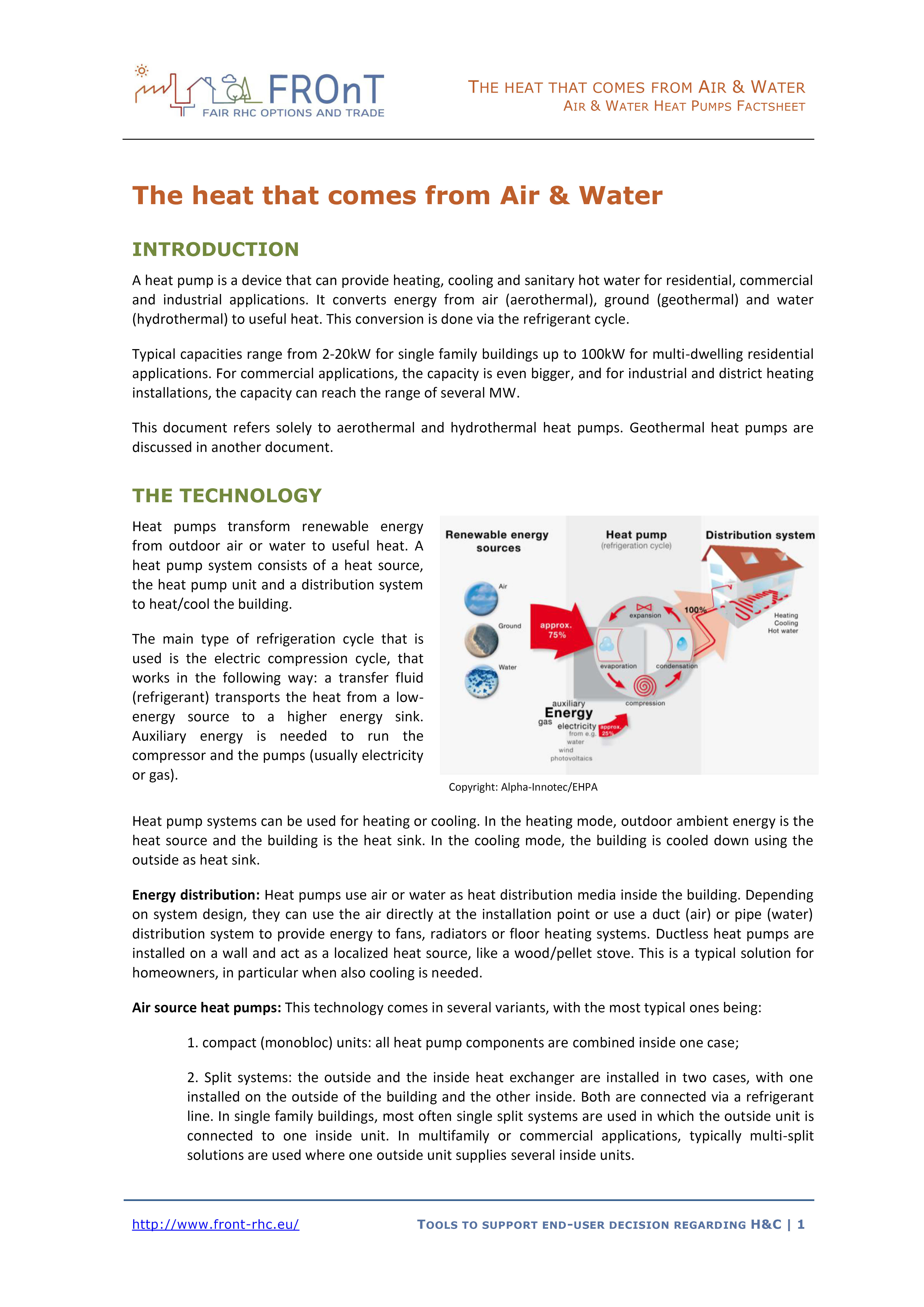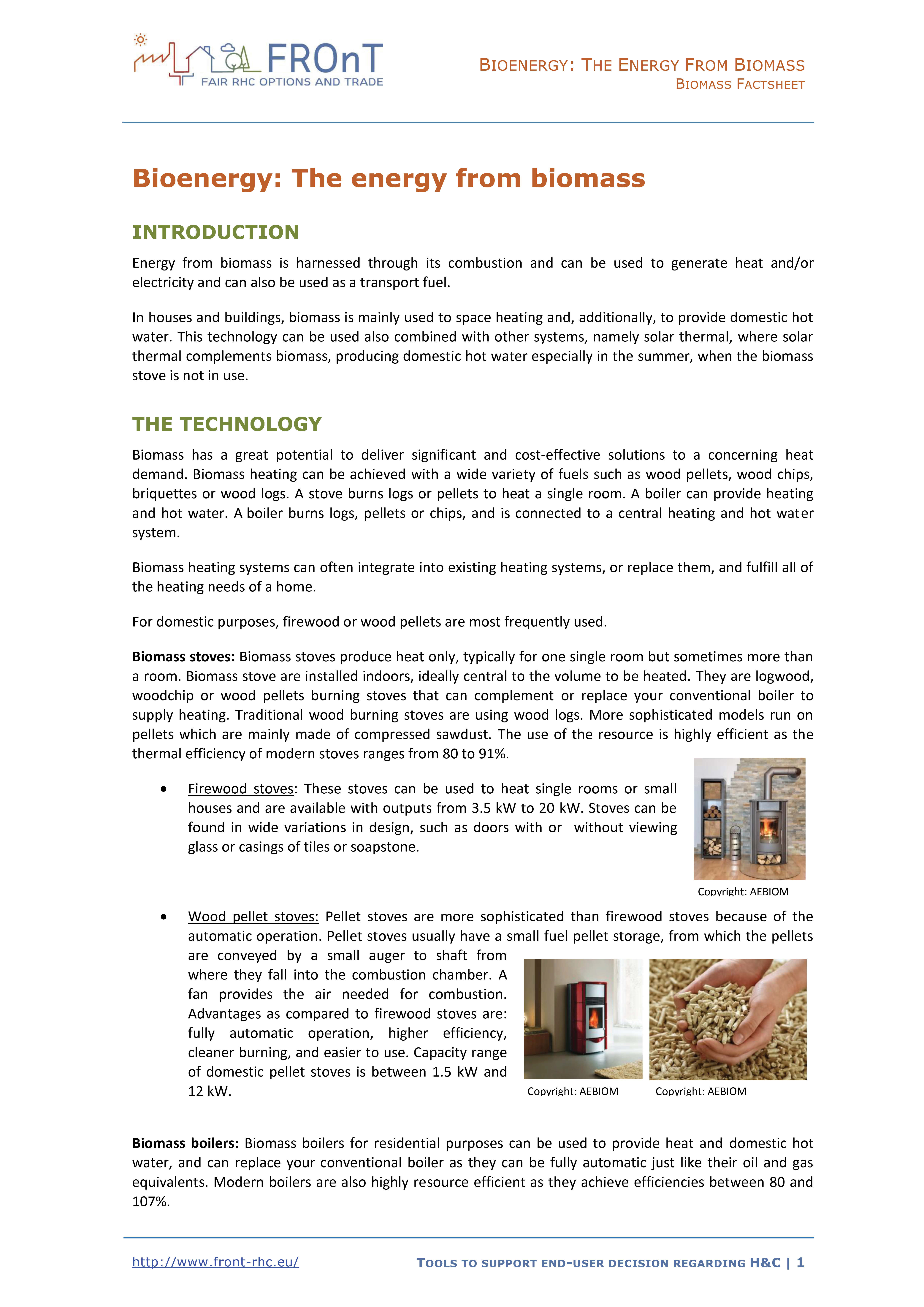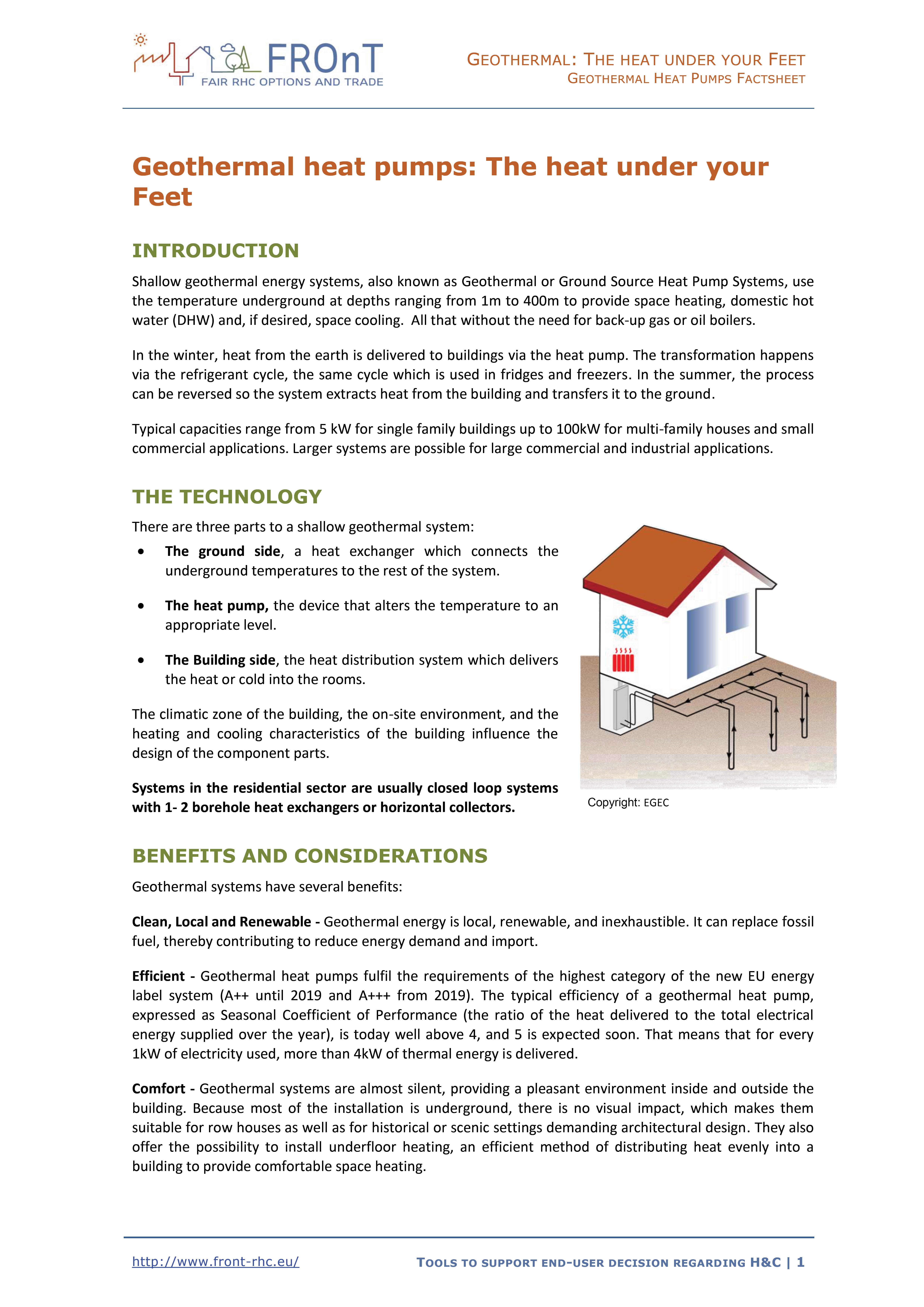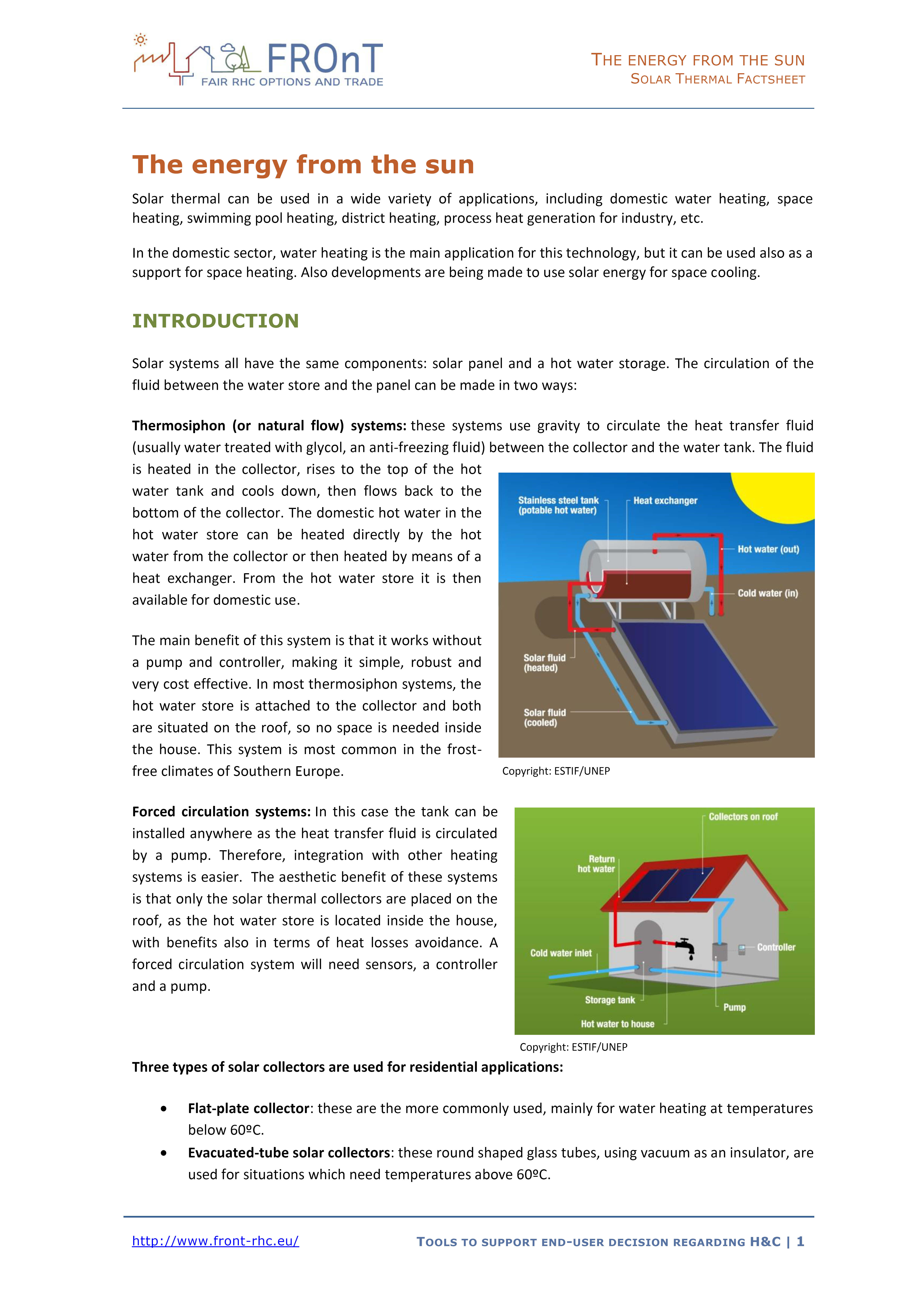This page contains a number of resources to help consumers understand how renewable heating and cooling works, and to help make decisions about what kind of system to use.
Discover RHC Technologies
Fact sheets about different renewable heating and cooling technologies
Download fact sheets explaining different types of technology
Frequently asked questions about
Heating and Cooling
In existing buildings
Download a pdf with all answers
Yes, if any of the following apply to you:
- Planned renovations in the house/building;
- Owning a boiler/air conditioner that broke down, or it is so old that it is becoming unreliable, its maintenance is becoming very expensive or parts unavailable;
- Witnessing an abnormal increase in your energy bill in the winter;
- Access to existing grants/favourable loans available to reduce the cost of purchasing new renewable space heating and cooling system;
- Owning a space cooling device or a boiler for heating and/or domestic hot water older than 15 years;
- Needing to improve your house energy performance certificate;
- Wanting a technology that is more reliable in terms of energy supply;
- Wanting to be more energy independent;
- Wanting to do something concrete to reduce your environmental footprint.
- If you have an old boiler/air conditioner: the replacement can be done to reduce significantly your energy bill. Conventional boilers with more than 15 years of usage are usually significantly less efficient than modern technologies and are likely to be reaching their expected lifetime. Similarly, air source heat pumps or air conditioners which are more than 15 years old have much lower levels of efficiency than recent equipment.
- If your energy bill is increasing when comparing the same heating period: it might indicate that your heating system is becoming less efficient. With the help of a professional you should evaluate whether the system should be repaired or replaced.
- If you have a boiler that uses fossil fuels you are using an equipment that:
1. Uses a fuel with prices that might highly fluctuate throughout the year and which are increasing over the long term;
2. Is not environmental friendly, since their use represents the emission of greenhouse gases and other pollutants to the atmosphere,
The ideal time to change your space heating and cooling system and switch to a renewable space heating and cooling system is:
- during construction and refurbishment,
- when your heat and cold demand is low (e.g. spring and summer),
- when your old boiler/cooler system becomes inefficient and costly.
You should evaluate if there are support and/or favourable loans available to help you implement these technologies and how this might affect your choice.
This need depends on the municipality/region you live in. Contact the local/regional authority that has responsibility in the building sector.
Also, your national/regional/local energy agency can help you clarify that question. You can find the contact of your energy agency in on the ManagEnergy site
One action to reduce your energy bill is evaluating how to improve the efficiency of your building, using insulation materials (roof, walls and floor, if possible) and installing efficient windows, which will reduce the heat losses.
You should make sure your equipment is efficient, with well insulated pipes, and if it uses renewable energy. On-site technologies that use renewable sources are: solar thermal panels, biomass stoves and boilers and heat pumps (geothermal/ground source, air source and water source systems).
Also, you should make sure it is used wisely. Ensure that a comfortable temperature is maintained, without the need for extra measures, such as opening windows to cool down heated spaces.
Remember that in an efficient building you can more easily integrate renewable technologies, such as an air source or geothermal heat pump, a biomass boiler or a solar collector!
All space heating and cooling, as well as water heating equipment up to 70 kW and capacities of up to 500 litres need to have an energy label. You can use this label to evaluate which equipment is more efficient and to compare different solutions.
It is very important to find certified/qualified technicians who know how to manage and install the technologies. Certified/qualified technicians can also help you to evaluate the best solution according to your needs.
You should always ask for at least two or three quotes, in order to compare prices and solutions. This way you can have a better perception of the real costs of the technology and get more in-depth information about how the technology works and what it needs.
Also, if possible, try to get information on the installers’ experience in this type of work, and visit an installation in order to understand better how it looks and works in practice.
Do not limit your assessment only to the investment cost, but always look for the life-cycle cost of the technology, at least for a period of 20 years.
If you are intending to have a centralised solution for all the house/building, you need to have more space than if you implement a solution for only one room in the house (e.g. a living room), specially with biomass and solar thermal systems. It is needed space for the boiler (in the cellar, for example), and in the case of biomass you also need space to store fuel. These situations are distinct and must be decided according to your needs and possibilities. A centralised solution can provide heat and cool for all the house while a solution for only one room will only heat or cool that part of the house.
In general terms, solar thermal panels also need roof space and a good solar orientation for you to be able to implement it (east, south or west).
An air-source heat pump has an outside unit (unlike a geothermal heat pump). The best situation is to put it in a space (balcony or a flat roof, for example) where it is not so visible, to preserve the house/building façade. But if that is not possible, the unit will have to be put in the façade directly. If the house is not your own or if there is any regulation considering the introduction of new elements in the façade, you will need to ask permission to your landlord or to the relevant authority.
In the case of geothermal heat pumps, you need a minimum of land available for drilling operations and in order to be able to implement this technology (20m2 for vertical systems and 150m2 for horizontal systems
Whenever the space heating/cooling resource available does not coincide with your space heating/cooling needs, you will need a backup system. Some technologies need a support system and others do not.
A solar system needs a support system for when there is no sun for several days, meaning the system will not work or work for few hours.
Heat pumps (air source and geothermal) system can provide space heating, cooling and domestic hot water with one single device without the need for a backup. But they always need a minimum of electricity to operate. A biomass system also needs electricity for its operation, for the fan and the pellet feeding system to be able to work.
Yes, depending on your space heating/cooling needs, an hybrid system can be the best option for your case. For example, if you only want space heating and water heating, a solution with biomass and solar panels can be interesting. Such systems might imply a higher upfront investment. Hence, you should compare it with other solutions that might be also adequate to your needs, namely in terms of lifetime costs and potential savings (and not only investment costs).
In another example, if you want to install a space heating system, which demands high temperatures, and hot water for a pool (which usually demands 30ºC), the combination of solar thermal energy and biomass could be a very good solution because each of them can be applied to each demand separately and be used in combination, if any of the demands stops eventually during certain periods.
Also, depending on the characteristics of your location and limitations you might face, having more than one technology might be a better solution, since they can complement one another, and provide the comfort you need better than if you only had one solution.
There are several good reasons why you should use renewable technologies:
- Renewable technologies make the consumers less dependent on carbon based technologies (gas, oil and non-renewable electricity), which prices might fluctuate and are subject to several pressures (market constrains, geopolitical issues and long term availability);
- Using renewable technologies is likely to lower your energy bills over time, hence you should not consider only the investment costs but also the operating costs (fuel and maintenance) over the lifetime of the system;
- It enhances the energy performance of the building, and therefore improve conditions for a better certificate. This will add value to the building, in case you want to rent or sell it, since the new users will also take advantage of the low energy bills during the use of the house/building.
- Additionally, it contributes to local development and job creation in your region. Even when such systems are not manufactured locally, there is always an important amount that is related to the sale, installation and maintenance that remains in the local economy.
Space heating and hot water needs are the biggest energy consumptions in the domestic sector. So, using renewable systems to heat/cool the building and heat water makes your consumption significantly greener.
Also, the way you use the equipment in your house/building can make the difference in your energy needs, so you should use them in the most efficient way possible, in order to reduce those needs, even if you are already using renewable energy.
Note that using renewable electricity, either self-produced or bought to a renewable energy producer, , will also make your consumption even greener.
In new buildings
Download a pdf with all the answers
If you are building a new house/building, first of all you need to take into account the building codes, including in terms of energy performance. Making an investment in a more efficient house/building (namely in insulation and efficient windows) while constructing can have a small marginal extra cost, but will bring big reductions in heating and cooling needs, so the investment will pay off while using the house over the years, and you are able to have renewable domestic hot water from the beginning.
Also, here is the time to consider which solution is more suitable for each case to assure the needs for heating, cooling and/or water heating, to integrate it in the beginning, while planning the house. Be aware that with a more efficient house/building the heating needs will be lower than in a traditional house, but the domestic hot water needs remain the same, so this specific use will have a greater impact on your energy needs.
All the solutions should be considered since the beginning, including hybrid renewable systems (e.g. mixed systems with biomass and solar thermal), in order for them to be well integrated in the construction, and have the fewer possible changes in this process, and for the house/building have the best energy classification.
Yet, a fair comparison of the technologies must be made. Choosing a technology should not only take into account the initial investment, but also the life-cycle cost and the environmental impact. Indeed, choosing renewable energy instead of a fossil-based systems is not only a major step to fight climate change, but it will also shelter you from future increasing prices on fossil fuels and carbon taxes on fossil fuels’ consumption.
To be able to achieve that, there are some steps that you need to take.
The first step is to contract an architect who knows how to plan a house/building in order to make it the most efficient possible.
The architect should discuss the project with all the specialists that will be a part of the construction, in order for all of them to be well integrated. You also must be involved in all the discussions: it is YOUR PROJECT.
The involved experts must consider all of the renewable energy options. Some factors that can condition the choices are the place where the house/building is going to be built, namely the natural or artificial barriers that can condition its behaviour, the solar radiation that it receives, among other things.
It is fundamental to understand that there is not one ideal solution for all situations. Each case is unique and all architectural and technical options should be chosen in order to give the best result for that specific case.
Never forget that sometimes you can pay a bit more in the beginning, but it will pay off over the years, it will value the construction, and you’ll have a house/building that has less impact in the environment.
The architect knows what entity do you have to submit your project to and the national /local regulation which must complied with.
The EU Energy Performance of Buildings Directive introduced the energy performance certificates for buildings. The building performance must be evaluated right in the beginning, in the project phase, in order to see if it complies with the legislation and if the energy level still can be improved. In the construction phase is where you can improve more the energy efficiency of a building with less costs.
Improvements can be made by increasing the insulation of the house (walls, floor and ceiling) and by choosing efficient windows. Also, the use of renewable technologies can be helpful to increase the building level of energy efficiency and reduce the needs of polluting fossil fuels, getting in line with the EU goal for decarbonising the building sector.
The equipment for heating, cooling and/or water heating will last in the house for several years, so it is important to invest in an efficient equipment using renewable energy. Energy label is already in the market for most equipments/systems (biomass systems will have the energy label in 2018). The investment in a more efficient equipment can be costly in the beginning, but over the years it will pay off.
Also, you must be aware when you get comparisons from different salesmen for different technologies. There are several factors affecting the real cost of each technology, and the levelized cost of energy (LCOE) allows a better comparison of different technologies, by including in its calculation the combination of capital costs, operations and maintenance (O&M), performance, and fuel costs. It comes in euros/energy, since it measures lifetime costs divided by energy production.
The system should be designed for the house/building needs, and not be oversized, otherwise you will have a bigger initial investment that what is needed and the system will not be as efficient. This will bring higher energy bills than it should be if the system was well dimensioned.
Also it is important to know how the system works, in order to optimize its operation. So getting the information from the installer on how the system should operate is important to reduce its consumption while working.
One question that is placed is if a backup system is needed when implementing renewables. The fact is that some technologies need a support system and others do not. A solar panel needs a support system for when there is no sun for several days, meaning the system will not work. Heat pumps (air source and geothermal) system can provide space heating, cooling and domestic hot water with one single device without the need for a backup. But they always need a minimum of electricity to operate. A biomass system also needs energy for its operation for the fan and the pellet supply system to be able to work.
In some countries, besides the mandatory legislation, there might exist:
- regional/municipal regulations that are more restrictive than the national legislation,
- benefits at the municipal/regional level for making a greener construction.
Also you should evaluate if there are support schemes for the installation of more efficient materials or renewable equipment, to help you lower your investment. For more questions contact your national or local/regional energy agency: http://www.managenergy.net/energy_agencies.








